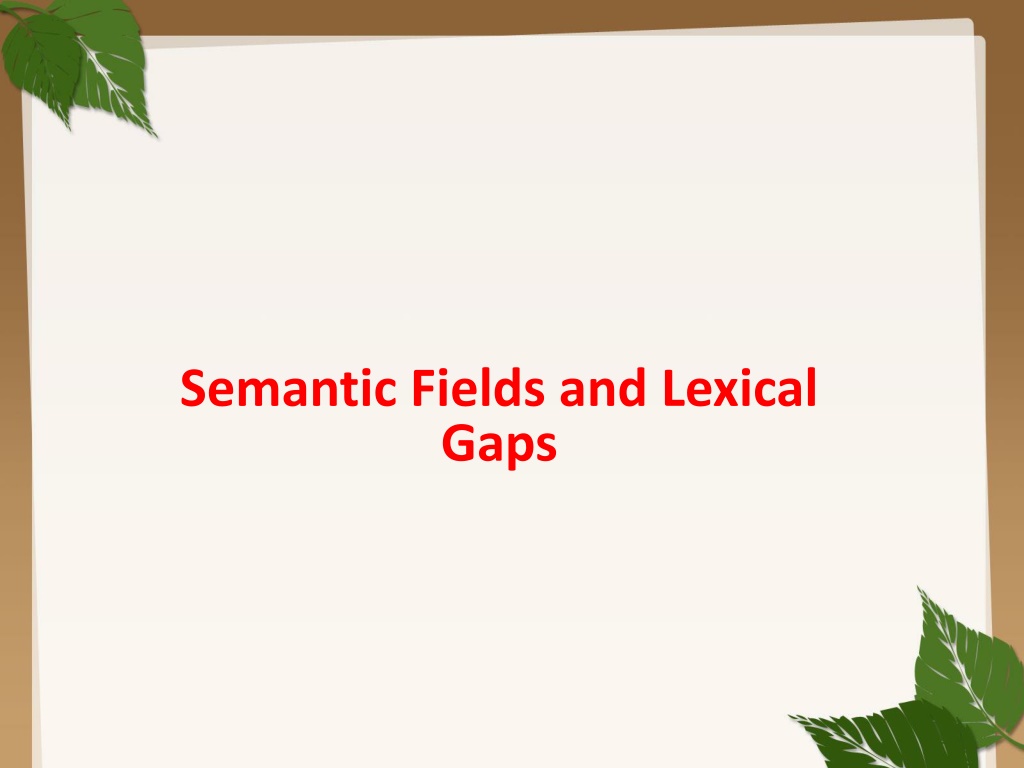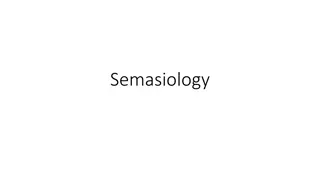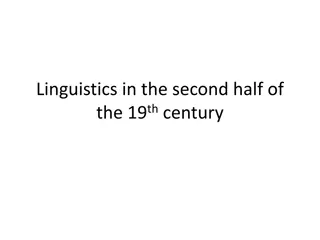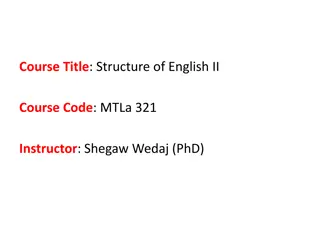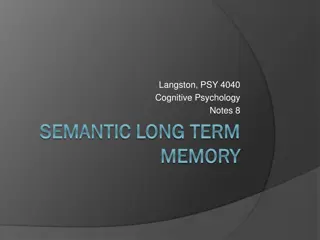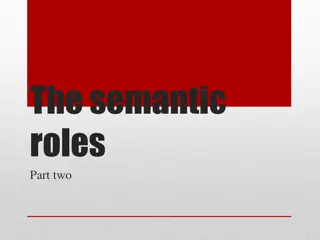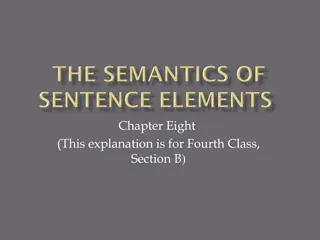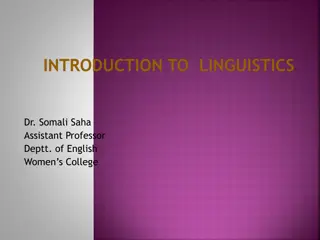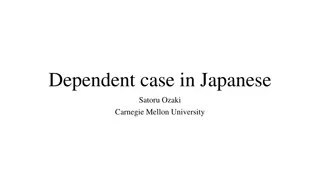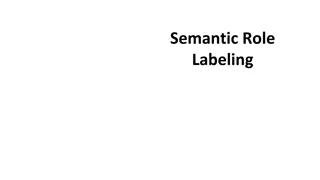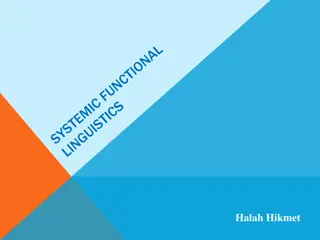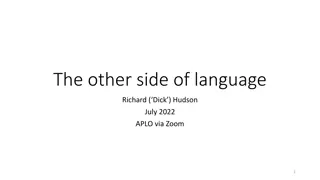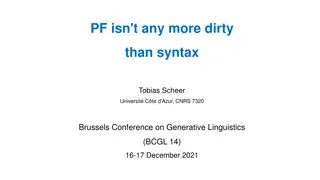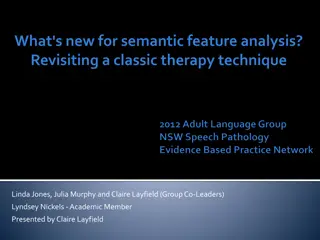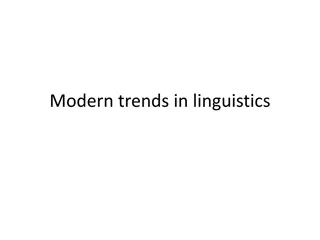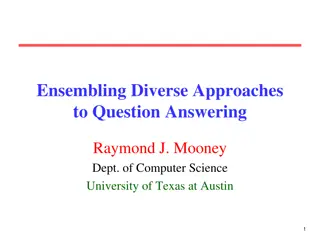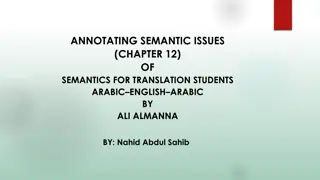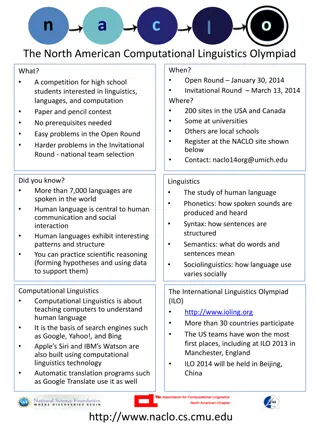Evolution of Semantic Field Theory in Linguistics
The theory of semantic fields, also known as field-theory, originated in the 1920s and 1930s with German and Swiss scholars. J. Trier and L. Weisgerber further developed this theory post World War II, associating it with the Language and Society movement. Trier's approach focused on comparing the structure of lexical fields over time, emphasizing the interrelated elements within a language's vocabulary system. Despite variations in terminology like "linguistic field," the essence of semantic fields remains key in understanding language evolution.
Download Presentation

Please find below an Image/Link to download the presentation.
The content on the website is provided AS IS for your information and personal use only. It may not be sold, licensed, or shared on other websites without obtaining consent from the author.If you encounter any issues during the download, it is possible that the publisher has removed the file from their server.
You are allowed to download the files provided on this website for personal or commercial use, subject to the condition that they are used lawfully. All files are the property of their respective owners.
The content on the website is provided AS IS for your information and personal use only. It may not be sold, licensed, or shared on other websites without obtaining consent from the author.
E N D
Presentation Transcript
What has now come to be known as the theory of semantic fields (or field-theory) was first put forward as such by a member of German and Swiss scholars in the 1920s and 1930s. The semantic field theory was brought into its puberty by German scholar J. Trier in the 1930s, whose version is seen as a new phase in the history of semantics Its origin, however, can be traced back at least to the middle of the nineteenth century. The semantic field theory was brought into its puberty by German scholar J. Trier in the1930s, whose version is seen as a new phase in the history of semantics( Ullmann, 1962: 7 ).
His ideas were further developed by his students and also by L. Weisgerber, who associated himself with Trier in the 1930s and continued to elaborate and refine his own theory of semantic field after the Second World War. Weisgerber ( 1954 ) explicit related his ideas to those of Trier in his contribution to a collection of articles celebrating Trier s work. Subsequently, he became the acknowledged leader of Language and Society movement, which has been responsible for some of the major publications in what by now might be called the Trier-Weisgerber theory. Trier in different works and in different parts of the same work, employs a variety of terms, and it is not always clear in what sense he is employing them. Trier does not explain what he means by sense and what he means by meaning and how each of these is to be distinguished from the obviously Saussurean value. He attempt to introduce Saussure s principles into semantics, The value ( Geltung ) of a word can only be determined by defining it in relation to the value of neighboring and contrasting words.
It is interesting to note that Trier (1931) himself the father of field theory did not use the term semantic field, but rather the term linguistic field. It is uncertain whether Trier distinguishes between lexical fields and semantic fields; Lyons (1977:253) says that semantic fields will vary from one language to another and from one period to another, depending on the way the speakers conceptualize the world around them. The procedure followed by Trier in diachronic semantics isn t one of comparing successive state of the total vocabulary. What he does is to compare the structure of a lexical field at time t1 with the structure of a lexical field at time t2. They are comparable because although they are different lexical fields (since they belong to different synchronic language-systems ), they cover the same conceptual field.
Trier looks upon the vocabulary of a language as an integrated system of lexemes interrelated in sense. The system is in constant flux. Both diachronic and synchronic linguistics must deal with systems of interrelated elements ; and diachronic linguistics presupposed synchronic linguistics.
The part-whole relationship which holds between individual lexemes and the lexical field within which they are interpreted is identical with, or at least similar to, the part-whole relationship which holds between the lexical fields and the totality of the vocabulary. Fields are living realities intermediate between individual words and the totality of the vocabulary. Color terminology provides a good illustration of differences in the lexical structure of different language systems. The lexical field of colors is structured differently in different languages and sometimes it is difficult to translate names of colors. Since the vocabularies of a language are semantically related, we are not supposed to study the semantic change of individual words in isolation, but to study vocabularies as an integrated system.
The application of this model to diachronic semantics. The lexeme braun covered a wider area of the conceptual field of color in eighteenth-century German than it does in present-day German, where it is in contrast with violet ( cf. Ohman, 1953: 133 ). Instead of saying that braun in the earlier period had two distinct senses ( brown and violet ), one of which it lost to violet, when this lexeme came into the language from French, as a traditional lexicographer or semanticist might be inclined to say, the field-theorist would maintain that the internal structure of the conceptual field ( as articulated by the two different lexical fields ) had changed between the two periods. Braun had only one sense, but a different sense, in each of the two language-systems.
As to the types of field modifications Lyons (1977:255) claims that while comparing two diachronically distinct lexical fields covering the same conceptual areas, one might come up with a cluster of five different combinations. 1) There is no change either in the lexemes included in the field, or in the relations that hold among them. 2) One of the lexemes is replaced with another one maintaining the internal structure of the field. 3) There is an alternation in the internal structure of the field leaving the set of lexemes unchanged.
A A B B B C A B C D A B C
4) There is both a change in the internal structure of the field and a replacement of one of the lexemes. 5) At least one of the lexemes has been added or lost with a change of the internal structure of the field
By time the semantic field KNOWLEDGE in German changed and although the number of lexemes remained the same, but the set of words was different, namely W sheit, Kunst and Wizzen. The first one came to be associated only with the knowledge of religion and mystical matters, the second one with art.
Criticism of Triers work There is much that can be criticized ( and has been criticized ) in Trier s work on the vocabulary of earlier stages of German from both a theoretical and a methodological point of view. The text upon which he based his analysis of the underlying language-systems are stylistically very restricted: they can hardly be taken as representative of the language as a whole.
First the selection of German lexemes may have been determined by a somewhat slavish attempt to represent the distinctions of sense associated with particular Latin lexemes in the originals by treating the German lexemes as translation equivalents. The second problem is that the linguist working on Middle High German texts of the kind used by Trier must often of necessity interpret the German in the light of the accompanying Latin It has sometimes been suggested by critics that field-theory is valid only for the analysis abstract words. Trier own model is in fact more obvious applicable to concrete conceptual fields than it is to abstract fields where they do not. The truth of the matter seems to be that the determining principles of lexical structure apply equally to both abstract and concrete words
Important contributions have been made to what may be described as field-theory by many other scholars. A number of American anthropologists have investigated the vocabulary of kinship, plants, disease, and other culturally important and variable systems of classification and have described their results in similar terms to the field- theorists.
One of the first analyses devoted to changing patterns within semantic fields was proposed by Trier (1931) . His analysis goes back to around 1200, where there existed in German three lexical items linked to the field KNOWLEDGE, i.e. Kunst, List and W sheit, each of which possessing a different shade of meaning. Each of which possessing a different shade of meaning. Namely, while Kunst was applied to the higher range of human wisdom in all aspects, including social behaviour, List encoded a lower range of knowledge with non-courtly connotation. W sheit, on the other hand, stood either for the synthesis of the two involving moral, aesthetic and religious factors, or an alternative to them bearing a general sense.
Weisberger gave semantic fields theory two of its major divisions. These are paradigmatic fieds and syntagmatic fields. Paradig field include words of the same form class that share semantic features(kitten, puppy). Syn fields include classes of word closely linked by usage, but never occuring in the same syntactic position (announce and microphone)
Lexical Gaps In linguistics an accidental gap, also known as a gap, lexical gap, lacuna, or a hole in the pattern, is a word or other form that does not exist in some language but which would be permitted by the grammatical rules of the language. An instance of a missing lexical items may be regarded as a lexical gap only if it corresponds to an event, action, or state of affairs which is conceivable. Lyons called it as matrix gaps (Lehrer, 1974:97). He defines it as empty slots in the structure of a lexical field. Lyons excludes cases of missing lexicalisations denotation objects which do not exist in a particular speech community which encapsulate the senses of contradictory syntagmatic modifiers (married bachelor). They do not correspond to concepts in speaker s minds (speakers can not have mental representations of objects they do not know. Speakers may find some kind of interpretation for these phrases (a married man behaving as if he were a bachelor).
Lyons concerned with two types of lexical gaps missing hyperonyms of existing co-hyponyms and missing hyponyms of existing hyperonyms. In English labels for superordinate terms for pairs of opposites such as go-come; teacher-puples and buy-sell. Speakers of English may use the adjective shalow to express the concepts DEEP TO SMALL DEGREE, there is no gap in the corresponding slot in the vocabulary of English. Lyons argues that the absence of a lexical expression meaning DEEP TO A SMALL DEGREE in French presents a clear case of a lexical gap. The phenomenon of lexical gaps essentially concerns the relation between concepts and lexical items.
